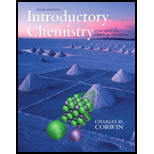
Concept explainers
(a)
Interpretation:
Whether the representative particle in propane is an atom, formula unit or molecule is to be stated.
Concept introduction:
The covalent bond is formed when two non-metals are combined by sharing the valence electrons. The particle that is held together by a covalent bond is known as a molecule. This can be identified when there are two non-metals in an atom.
(b)
Interpretation:
Whether the representative particle in chromium is an atom, formula unit or molecule is to be stated.
Concept introduction:
The atom is the basic unit of a particle that cannot be broken by any chemical means. The atom shows the property of an element. Every state is composed of a neutral or an ionized atom.
(c)
Interpretation:
Whether the representative particle in hematite is an atom, formula unit or molecule is to be stated.
Concept introduction:
In an ionic bond, the cation is attracted to an anion. This attraction is due to the opposite charges on both the ions. The particle that is held together by an ionic bond is known as formula unit. This can be identified when the particle has a metal and a non-metal.
(d)
Interpretation:
Whether the representative particle in sulfur is an atom, formula unit or molecule is to be stated.
Concept introduction:
The covalent bond is formed when two non-metals are combined by sharing the valence electrons. The particle that is held together by a covalent bond is known as a molecule. This can be identified when there are two non-metals in an atom.
Want to see the full answer?
Check out a sample textbook solution
Chapter 12 Solutions
Introductory Chemistry: Concepts And Critical Thinking, Books A La Carte Edition (8th Edition)
- Without consulting any tables, arrange the following substances in order and explain your choice of order: (a) Mg2+,Ar,Br,Ca2+ in order of increasing radius (b) Na, Na+ , O, Ne in order of increasing ionization energy (c) H, F, Al, O in order of increasing electronegativityarrow_forwardSome chemical reactions proceed by the in it ial loss or transfer of an electron to a diatomic species. Which of the molecules N2, NO. O2, C2, F2, and CN would you expect to be stabil ized by (a) the addit ion of an electron to form AB-. (b) the removal of an electron to form AB+?arrow_forwardAluminum oxide (Al₂ O₃) is a widely used industrial abrasive(emery, corundum), for which the specific application depends onthe hardness of the crystal. What does this hardness imply about the magnitude of the lattice energy? Would you have predictedfrom the chemical formula that Al₂ O₃ is hard? Explain.arrow_forward
- Elements in the same group of the periodic table often formoxyanions with the same general formula. The anions arealso named in a similar fashion. Based on these observations,suggest a chemical formula or name, as appropriate, for eachof the following ions: (a) BrO4-, (b) SeO32-, (c) arsenate ion,(d) hydrogen tellurate ion.arrow_forward(c) Theoretically, define the following elements in the formulae belowPth = ρghq x ŋarrow_forwardThe atoms in the formula 4CH3oH isarrow_forward
- Which of the following particle diagrams would be represented by the compound Hydrogen bromide, HBr? A D C B Earrow_forwardIn a lithium-ionbattery that is discharging to power a device, for every Li+that inserts into the lithium cobalt oxide electrode, a Co4+ion must be reduced to a Co3+ ion to balance charge. Usingthe CRC Handbook of Chemistry and Physics or other standardreference, find the ionic radii of Li+, Co3+, and Co4+. Orderthese ions from smallest to largest.arrow_forwardAre noble gases considered to have electro negativity? Why or why not?arrow_forward
- In which of the following compounds does hydrogen bear a partial negative charge: (a) CH4, (b) NH3, (c) H2O, (d) SiH4 or (e) H2S?arrow_forwardMethyl isocyanate, , is an intermediate in the manufacture of many pesticides. It received notoriety in1984 when a leak from a manufacturing plant resulted in thedeath of more than 2000 people in Bhopal, India. What are thehybridizations of the N atom and the two C atoms in methyl iso-cyanate? Sketch the molecular shapearrow_forwardSo if 2n^2 could predict the maximum number of electrons in the n shell. Then the 3rd shell should hold 18 electrons since chlorine has 17 electrons in a neutral state how come we say it pursues the octet rule despite it being able to hold 18 electrons? For example, it's shown during an ionic transfer with Na to gain an electron and be satisfied occurring to the octet rule. Please explain does it have to deal with the orbitals?arrow_forward
 General Chemistry - Standalone book (MindTap Cour...ChemistryISBN:9781305580343Author:Steven D. Gammon, Ebbing, Darrell Ebbing, Steven D., Darrell; Gammon, Darrell Ebbing; Steven D. Gammon, Darrell D.; Gammon, Ebbing; Steven D. Gammon; DarrellPublisher:Cengage Learning
General Chemistry - Standalone book (MindTap Cour...ChemistryISBN:9781305580343Author:Steven D. Gammon, Ebbing, Darrell Ebbing, Steven D., Darrell; Gammon, Darrell Ebbing; Steven D. Gammon, Darrell D.; Gammon, Ebbing; Steven D. Gammon; DarrellPublisher:Cengage Learning Principles of Modern ChemistryChemistryISBN:9781305079113Author:David W. Oxtoby, H. Pat Gillis, Laurie J. ButlerPublisher:Cengage Learning
Principles of Modern ChemistryChemistryISBN:9781305079113Author:David W. Oxtoby, H. Pat Gillis, Laurie J. ButlerPublisher:Cengage Learning General, Organic, and Biological ChemistryChemistryISBN:9781285853918Author:H. Stephen StokerPublisher:Cengage Learning
General, Organic, and Biological ChemistryChemistryISBN:9781285853918Author:H. Stephen StokerPublisher:Cengage Learning
 Introduction to General, Organic and BiochemistryChemistryISBN:9781285869759Author:Frederick A. Bettelheim, William H. Brown, Mary K. Campbell, Shawn O. Farrell, Omar TorresPublisher:Cengage Learning
Introduction to General, Organic and BiochemistryChemistryISBN:9781285869759Author:Frederick A. Bettelheim, William H. Brown, Mary K. Campbell, Shawn O. Farrell, Omar TorresPublisher:Cengage Learning Introductory Chemistry: A FoundationChemistryISBN:9781337399425Author:Steven S. Zumdahl, Donald J. DeCostePublisher:Cengage Learning
Introductory Chemistry: A FoundationChemistryISBN:9781337399425Author:Steven S. Zumdahl, Donald J. DeCostePublisher:Cengage Learning





